Frigidaire FGHG2368TF Maintance Manual
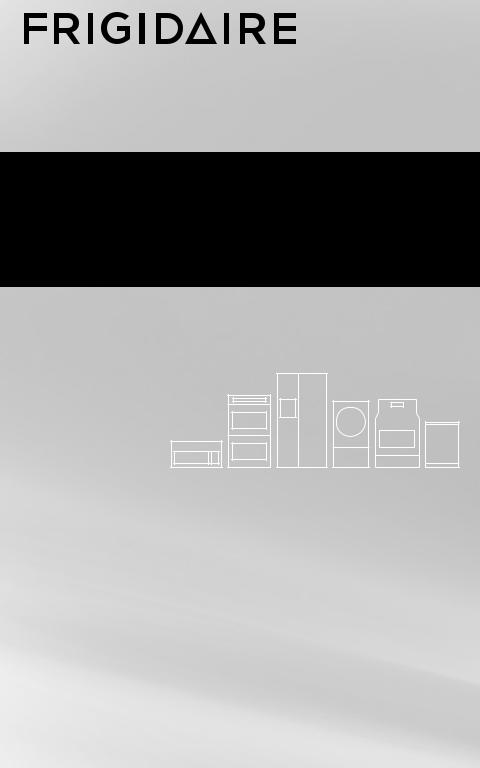
All about the
Use&Care
of your Refrigerator
TA B L E O F C O N T E N T S
Important Safety Instructions...................... |
2 |
Features at a Glance................................... |
4 |
Installation................................................. |
5 |
Door Removal Instructions........................... |
8 |
Installing Door Handles............................. |
10 |
Connecting Water Supply.......................... |
12 |
Controls................................................... |
14 |
Automatic Ice & Water Dispenser............... |
22 |
Automatic Ice Maker - Freezer................... |
24 |
Storage Features...................................... |
25 |
Storing Food and Saving Energy................ |
29 |
Normal Operating Sounds and Sights......... |
30 |
Changing the Filter................................... |
31 |
Care and Cleaning..................................... |
33 |
Before you Call......................................... |
35 |
Major Appliance Warranty.......................... |
40 |
www.frigidaire.com USA 1-800-944-9044 |
www.frigidaire.ca Canada 1-800-265-8352 |
2017) (July A05947002

IMPORTANT SAFETY INSTRUCTIONS

 WARNING
WARNING
Please read all instructions before using this refrigerator.
For your Safety
•DO NOT store or use gasoline, or other flammable liquids in the vicinity of this or any other appliance. Read product labels for warnings regarding flammability and other hazards.
•DO NOT operate the refrigerator in the presence of explosive fumes.
•Avoid contact with any moving parts of automatic ice maker.
•Remove all staples from the carton. Staples can cause severe cuts, and also destroy finishes if they come in contact with other appliances or furniture.
Definitions
 This is the safety alert symbol. It is used to alert you to potential personal injury
This is the safety alert symbol. It is used to alert you to potential personal injury
hazards. Obey all safety messages that follow this symbol to avoid possible injury or death.

 DANGER
DANGER
DANGER indicates an imminently hazardous situation which, if not avoided, will result in death or serious injury.

 WARNING
WARNING
WARNING indicates a potentially hazardous situation which, if not avoided, could result in death or serious injury.

 CAUTION
CAUTION
CAUTION indicates a potentially hazardous situation which, if not avoided, may result in minor or moderate injury.

 IMPORTANT
IMPORTANT
IMPORTANT indicates installation, operation or maintenance information which is important but not hazard-related.

 Installation Checklist
Installation Checklist
Doors
Handles are secure and tight
Door seals completely to cabinet on all sides
Leveling
Refrigerator is level side-to-side and slightly elevated in front to assist with door and drawer closing (front should be higher than back)
Toe grille is properly attached to refrigerator
Cabinet is setting solid on all corners
Electrical Power
House power turned on
Refrigerator plugged in
Ice Maker
House water supply connected to refrigerator
No water leaks present at all connections - recheck in 24 hours
Ice maker is turned ON
Ice & water dispenser operates correctly
Final Checks
Shipping material removed
Fresh food and freezer temperatures set
Crisper humidity controls set
Registration card sent in
Child Safety
Destroy or recycle the carton, plastic bags, and any exterior wrapping material immediately after the refrigerator is unpacked. Children should NEVER use these items to play. Cartons covered with rugs, bedspreads, plastic sheets or stretch wrap may become airtight chambers, and can quickly cause suffocation.
Proper Disposal of your Refrigerator or Freezer
Risk of child entrapment
Child entrapment and suffocation are not problems of the past. Junked or abandoned refrigerators or freezers are still dangerous
– even if they will sit for “just a few days”. If
2
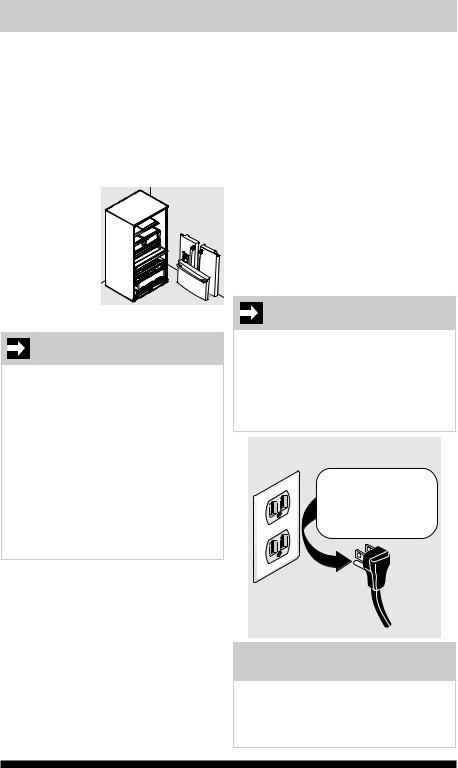
IMPORTANT SAFETY INSTRUCTIONS
you are getting rid of your old refrigerator or freezer, please follow the instructions below to help prevent accidents.
Proper Disposal of Refrigerators/Freezers
We strongly encourage responsible appliance recycling/disposal methods. Check with your utility company or visit www.energystar.gov/recycle for more information on recycling your old refrigerator.
Before you throw away your old refrigerator/freezer:
• Remove doors.
• Leave shelves
in place so children may not easily climb
inside.
• Have refrigerant removed by a qualified service technician.
IMPORTANT
CFC/HCFC Disposal
Your old refrigerator may have a cooling system that used CFCs or HCFCs (chlorofluorocarbons or hydrochlorofluorocarbons). CFCs and HCFCs are believed to harm stratospheric ozone if released to the atmosphere. Other refrigerants may also cause harm to the environment if released to the atmosphere.
If you are throwing away your old refrigerator, make sure the refrigerant is removed for proper disposal by a qualified technician. If you intentionally release refrigerant, you may be subject to fines and imprisonment under provisions of environmental legislation.
Electrical information
•The refrigerator must be plugged into its own dedicated 115 Volt, 60 Hz., 15 Amp, AC only electrical outlet. The power cord of the appliance is equipped with a threeprong grounding plug for your protection against electrical shock hazards. It must be plugged directly into a properly grounded three prong receptacle. The receptacle must be installed in accordance with local codes and ordinances. Consult a qualified electrician. Avoid connecting refrigerator to a Ground Fault Interrupter (GFI) circuit. Do not use an extension cord or adapter plug.
•If the power cord is damaged, it should be replaced by an authorized service technician to prevent any risk.
•Never unplug the refrigerator by pulling on the power cord. Always grip the plug firmly, and pull straight out from the receptacle to prevent damaging the power cord.
•Unplug the refrigerator before cleaning and before replacing a light bulb to avoid electrical shock.
•Performance may be affected if the voltage varies by 10% or more. Operating the refrigerator with insufficient power can damage the compressor. Such damage is not covered under your warranty.
•Do not plug the unit into an electrical outlet controlled by a wall switch or pull cord to prevent the refrigerator from being turned off accidentally.
IMPORTANT
Pressing and holding the On/Off button for three seconds, located on the temperature control panel, will disable your refrigerator’s cooling system but does not disconnect the power to the light bulb and other electrical components. To turn off power to your refrigerator you must unplug the power cord from the electrical outlet.
Grounding type wall receptacle
Do not, under
any circumstances, cut, remove,
or bypass the grounding prong.
Power cord with 3-prong grounded plug

 CAUTION
CAUTION
To avoid personal injury or property damage, handle tempered glass shelves carefully. Shelves may break suddenly if nicked, scratched, or exposed to sudden temperature change.
3

FEATURES AT A GLANCE
*Features may vary according to model
*Ice Bin |
*Fresh Food |
*Air |
Flipper |
*Water |
*Dairy |
Flipper |
Ice Maker |
Filter |
Guide |
Filter |
Compartment |
Mullion |
*Can Rack |
*Air |
|
Filter |
||
|
||
*Flip Shelf |
Spillsafe® |
|
Shelves |
||
|
||
|
*Slide-Under |
|
|
Shelf |
Crisper
Drawer
Deli
Drawer 
|
*Door Bin |
Adjustable Hinges |
|
*Freezer Ice |
Freezer Baskets |
Maker |
|
*Removable |
|
Ice Bin |
*Toe Grille |

 IMPORTANT
IMPORTANT
Features not purchased with your refrigerator can be purchased at www.frigidaire.com or by calling 1-800-944-9044.
4
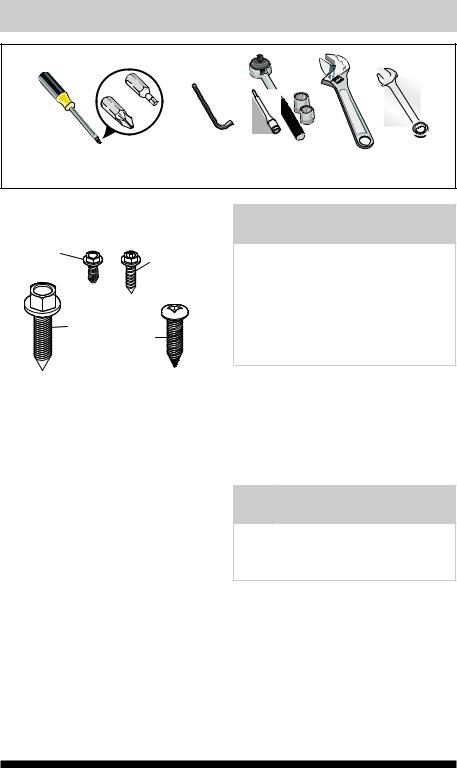
INSTALLATION
Tools Necessary: |
|
|
|
|
(OR) |
AND |
OR |
OR |
|
Phillips Head |
|
⅜" and ¼" |
|
|
or |
6mm |
Adjustable |
⅜" Fixed |
|
Quadrex Head |
Socket |
|||
Screwdriver |
Allen Wrench |
Wrench |
Wrench |
Wrench |
Components Provided:
Top Hinge |
Top Hinge |
Cover Front |
Cover Rear |
Screw |
Screw |
Top |
Lower |
Hinge |
Hinge |
Screw |
Screw |
This Use & Care Guide provides general installation and operating instructions for your model. We recommend using a service or kitchen contracting professional to install
your refrigerator. Use the refrigerator only as instructed in this Use & Care Guide. Before starting the refrigerator, follow these important first steps.

 CAUTION
CAUTION
Do Not install the refrigerator where the temperature will drop below 55°F (13°C) or rise above 110°F (43°C). The compressor will not be able to maintain proper temperatures inside the refrigerator.
Do Not block the toe grille on the lower front of your refrigerator. Sufficient air circulation is essential for the proper operation of your refrigerator.
Installation
Allow the following clearances for ease of installation, proper air circulation, and plumbing and electrical connections:
Sides & Top |
⅜ inch (9.5 mm) |
Back |
1 inch (25.4 mm) |
Location
•Choose a place that is near a grounded, non-GFCI, electrical outlet. Do Not use an extension cord or an adapter plug.
•If possible, place the refrigerator out of direct sunlight and away from the range, dishwasher, or other heat sources.
•The refrigerator must be installed on a floor that is level and strong enough to support a fully loaded refrigerator.
•Consider water supply availability for models equipped with an automatic ice maker.
NOTE
If your refrigerator is placed with the door hinge side against a wall, you may have to allow additional space so the door can be opened wider.
Door opening
Your refrigerator should be positioned to allow easy access to a counter when removing food. For best use of refrigerator drawers and freezer baskets, the refrigerator should be in a position where both can be fully opened.
5

INSTALLATION |
|
|
CAUTION |
|
|
Do Not loosen or remove these 3 hex screws. |
|
|
|
Door |
Door |
DO NOT |
|
|
Loosen |
|
|
or |
|
|
Remove |
|
|
These 3 |
|
|
Hex |
|
Raise |
Screws |
Anti-tip |
|
|
|
|
|
Leg |
|
|
|
Lower |
|
5 Install the toe grille by fitting into place. |
|
Cabinet Leveling & Refrigerator Door Alignment (if necessary)
Guidelines for final positioning of your refrigerator:
•All four corners of the cabinet must rest firmly on the floor.
•The front should be slightly elevated to ensure that doors close and seal properly.
•Doors should align with each other and be level.
Most of these conditions can be met by raising or lowering the adjustable front rollers.
To level the cabinet using the front rollers:
1Slightly open freezer drawer if the toe grill is installed. Lift the toe grille and gently pull forward.
2Make initial cabinet adjustments by using the front roller height adjusting screws. Use a 3/8 inch socket wrench to turn the adjustment screws (1 per side).
To raise: turn adjustment screw clockwise.
To lower: turn adjustment screw counterclockwise.
3Ensure both doors are bind-free with their seals touching the cabinet on all four sides and that cabinet is stable.
4After unit is leveled, lower anti-tip leg using a 3/8 inch socket wrench until it firmly contacts the floor.
Toe Grille Must |
Fit in Slot on |
Anti-tip Bracket |
Screw/Washer |
Assembly |
 (2) Retaining Clips
(2) Retaining Clips 
To make final door height adjustments:
1.Open freezer drawer to make lower hinge visible.
2.Insert 6mm Allen wrench into the shaft of the lower hinge.
3.Adjust the height by turning clockwise or counterclockwise. Turning clockwise will lower the door. Turning counterclockwise will raise the door. Default setting is to the lowest height when you receive your appliance.
Raise
6
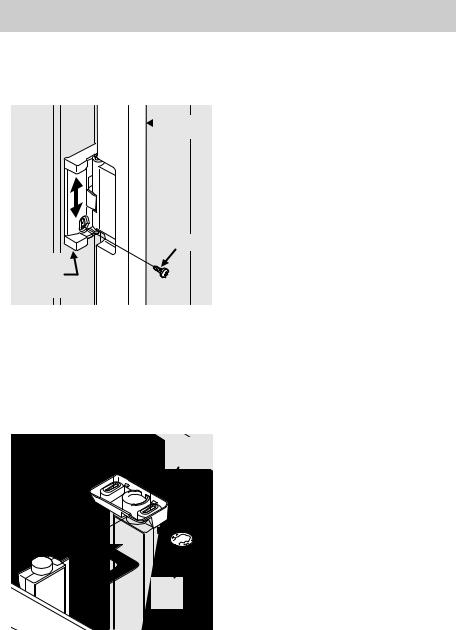
INSTALLATION
To adjust the flipper mullion:
1Loosen the screw located on the flipper mullion hinge.
Flipper
Mullion
Screw
Flipper
Mullion
Hinge
Adjusting Flipper Mullion Screw
2Adjust flipper mullion height. For proper connection with the flipper mullion guide, there should be a separation about the thickness of a coin (0.060 inches, or
1.5 mm) between the guide and flipper mullion.
Mullion
Guide
Flipper
Mullion
Thickness
of a Coin
Adjusting Flipper Mullion Height
3 Re-tighten screw.
7
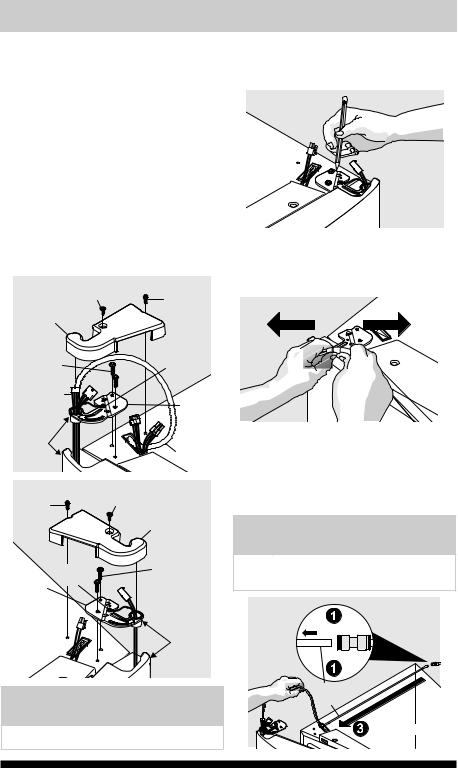
DOOR REMOVAL INSTRUCTIONS
Getting through narrow spaces
If your refrigerator will not fit through an entrance area, you can remove the doors.
Check first by measuring the entrance.
To prepare for removing the doors:
1Make sure the electrical power cord is unplugged from the wall outlet.
2Open the freezer drawer and remove the toe grille (see Installation section).
3Remove any food from the door shelves and close the doors.
To remove the top hinge covers:
1Remove the two screws from each cover over the top door hinges.
2Lift inside edge of hinge cover and tilt back.
|
Front |
Rear |
|
Cover Screw |
|
|
Cover |
|
Top Hinge |
Screw |
|
Cover |
|
|
Hinge |
Ground |
|
Screws |
Screw |
|
Multi-wire |
|
|
Cables |
|
Top |
Leave |
|
Hinge |
|
|
|
Hinge |
|
|
With |
|
Water |
Door |
|
Line |
Rear |
Front |
|
Cover Screw |
|
|
Cover |
|
|
Screw |
|
Top Hinge |
|
|
|
|
|
Cover |
Top |
Ground |
Hinge |
Screws |
||
Hinge |
Screw |
|
Leave
Hinge
With
Door
NOTE
DO NOT remove the ground screw from hinge.
To remove the refrigerator doors
1Trace lightly around the door’s top hinges with a pencil. This makes reinstallation easier.
2Disconnect the harness by grasping both sides of the connector firmly, depress the latch, and pull apart. Remove the two screws from the top hinge. Lift the door off of the bottom hinge and set it aside.
3Detach the water tube from the connector located behind the refrigerator and pull the tube back out to the front of the unit. The connector releases when you press inward on the outer sleeve while pushing the tube toward the connector then while continuing to hold in the sleeve, pull the tube away.
NOTE
Use care while pulling the water tube from the unit to be sure that you do not kink the tube.

 Press
Press

 Press
Press
Water
Line
Approximately
5 feet
8
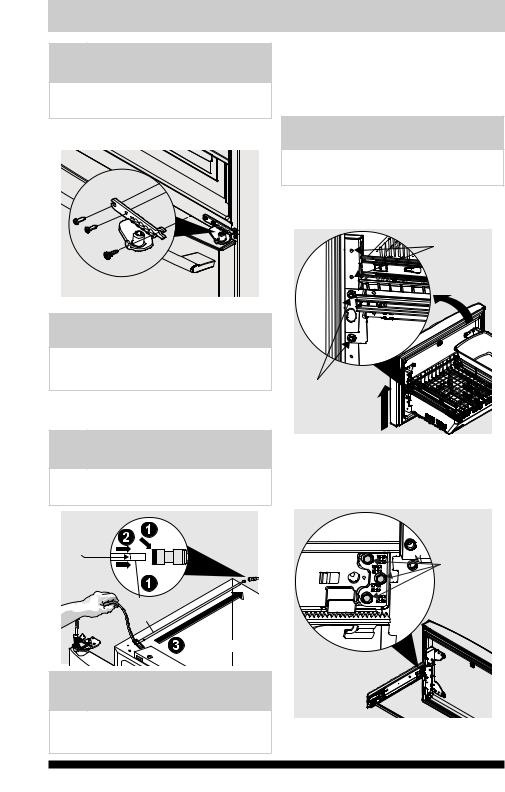
DOOR REMOVAL INSTRUCTIONS
NOTE
You will be pulling approximately five feet of water tube from the back of the refrigerator.
4Unscrew the three lower hinge screws and slide the hinge inwards.
Lower Hinge Removal

 CAUTION
CAUTION
Be sure doors are set aside in a secure position where they cannot fall and cause personal injury, or damage to the doors or handles.
To reinstall the refrigerator doors:
Reverse the above steps.
Once both doors are in place, ensure they are aligned with each other and level (Please see the Installation section for more details), and replace the top hinge cover.
Removing Freezer Drawer

 CAUTION
CAUTION
Drawer is heavy. Use caution when lifting.
1Remove 4 hex head drawer screws.
2Lift up drawer to remove.


 DO NOT
DO NOT

















 Remove
Remove
Other
Screws
Remove
Hex Head
Drawer Screw
NOTE
Upon replacement, the tube needs to be fully inserted up to the marking line.
Insert tube up to the
marking Press line

 Press
Press
Water
Line
Approximately 5 feet
NOTE
When reinserting the water tube and replacing the top hinge cover, use care to be sure you do not kink the tube.
Re-installing Freezer Drawer
1Lower drawer back into place.
2Replace 4 hex head drawer screws and tighten.
DO NOT

 Loosen
Loosen
or
Remove
These 3
Hex
Screws
9
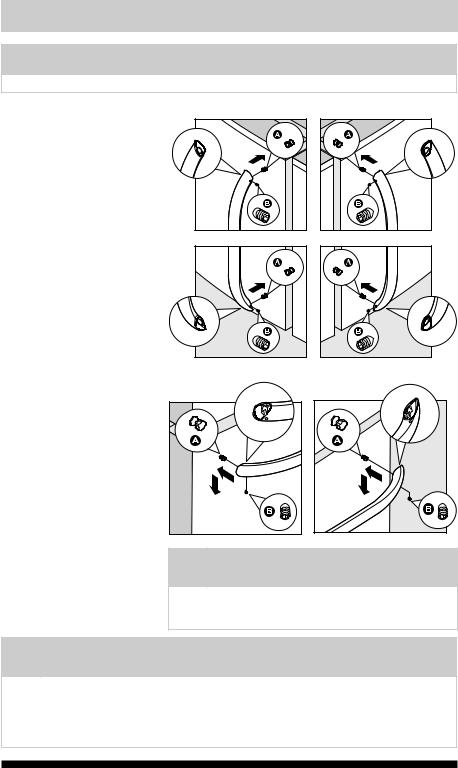
INSTALLING DOOR HANDLES

 CAUTION
CAUTION
Wear gloves and safety goggles. Use extreme CAUTION when installing these handles.
Door Handle Mounting Instructions for Frigidaire
&Frigidaire Gallery
1Remove handles from carton and any other protective packaging.
2Position fresh food handle end caps over upper and lower pre-installed shoulder bolts (A) that are fastened into door, ensuring the holes for the set screws are facing towards the opposite door.
3While holding handle firmly against door, fasten upper and lower Allen set screws (B) with supplied Allen wrench.
4Repeat steps 2 and 3 to install opposite handle. Ensure the holes for the set screws are facing towards the first door.
5Position freezer handle end caps over left and right preinstalled shoulder bolts (A) that are fastened to the door, ensuring the holes for the set screws are facing down.
6While holding handle firmly against door, loosely tighten right Allen set screw (B) with supplied Allen wrench until there is no gap between handle and door.
7Still holding the handle firmly to the door, firmly tighten left Allen set screw (B) with supplied Allen wrench.
8Return to the right Allen set screw (B) and firmly tighten with supplied Allen wrench.
Mounting Refrigerator Handles
Mounting Freezer Handle
NOTE
When tightening the Allen set screws, it is imperative that force be applied to the longer arm of the Allen wrench supplied in the handle packaging.
NOTE
All set screws should be tightened so the screw is below the surface of the handle. The handles should be drawn tight to freezer and refrigerator doors with no gaps. Opening the opposite door while tightening the Allen screw makes installation easier.
The door handle may loosen over time or if it was installed improperly. If this happens, tighten the set screws on the handles.
10
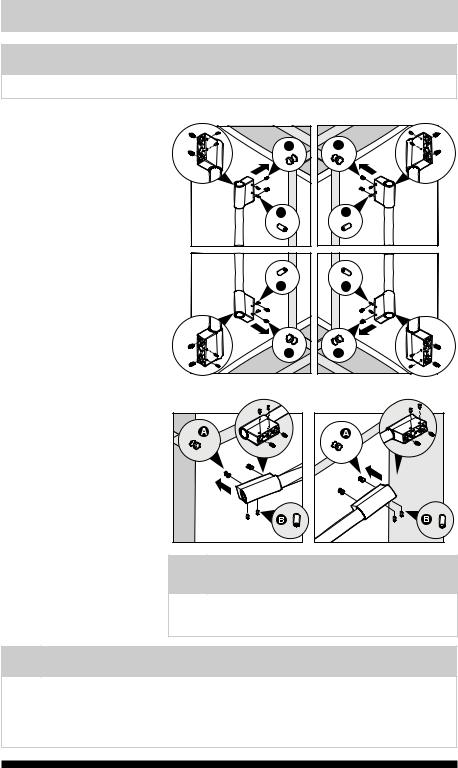
INSTALLING DOOR HANDLES

 CAUTION
CAUTION
Wear gloves and safety goggles. Use extreme CAUTION when installing these handles.
Door Handle Mounting |
Mounting Refrigerator Handles |
||
Instructions for |
|
|
|
Frigidaire Professional® |
A |
A |
|
1 Remove handles from carton and |
|
||
|
|
||
any other protective packaging. |
|
|
|
2 Position fresh food handle end |
|
|
|
over upper and lower pre- |
|
|
|
installed shoulder bolts (A) that |
B |
B |
|
are fastened into door, ensuring |
|||
the holes for the set screws are |
|
|
|
facing towards the opposite door. |
|
|
|
3 While holding handle firmly |
|
|
|
against door, fasten further |
|
|
|
most upper and further most |
|
|
|
lower Allen set screws (B) with |
B |
B |
|
supplied Allen wrench. |
|
|
|
4 Repeat steps 2 and 3 to install |
|
|
|
opposite handle. Ensure the |
|
|
|
holes for the set screws are |
|
|
|
facing towards the first door. |
A |
A |
|
5 Firmly tighten the inside Allen |
|||
|
|
||
set screws. |
Mounting Freezer Handle |
||
6 Position freezer handle end |
|||
over left and right pre-installed |
|
|
|
handle shoulder bolts (A) |
|
|
|
that are fastened to the door, |
|
|
|
ensuring the holes for the set |
|
|
|
screws are facing down. |
|
|
|
7 While holding handle firmly against door, loosely tighten far right Allen set screw (B) with supplied Allen wrench until there is no gap between handle and door.
8 |
Still holding the handle firmly |
|
|
|
to the door, firmly tighten far |
|
|
|
left Allen set screw (B) with |
NOTE |
|
|
supplied Allen wrench. |
||
9 |
Return to the far right Allen set |
||
|
screw (B) and firmly tighten |
When tightening the Allen set screws, it is imperative that |
|
|
with supplied Allen wrench. |
||
|
force be applied to the longer arm of the Allen wrench |
||
10 |
Firmly tighten the inside Allen |
||
supplied in the handle packaging. |
|||
|
set screws. |
||
|
|
NOTE
All set screws should be tightened so the screw is below the surface of the handle. The handles should be drawn tight to freezer and refrigerator doors with no gaps. Opening the opposite door while tightening the Allen screw makes installation easier.
The door handle may loosen over time or if it was installed improperly. If this happens, tighten the set screws on the handles.
11

CONNECTING THE WATER SUPPLY

 WARNING
WARNING
To avoid electric shock, which can cause death or severe personal injury, disconnect the refrigerator from electrical power before connecting a water supply line to the refrigerator.
•A shutoff valve to connect the water supply line to your household water system. DO NOT use a self-piercing type shutoff valve.
•Do not re-use compression fitting or use thread seal tape.
•A compression nut and ferrule (sleeve) for connecting a copper water supply line to the ice maker inlet valve.

 CAUTION
CAUTION
To Avoid Property Damage:
•Copper or Stainless Steel braided tubing is recommended for the water supply line. Water supply tubing made of ¼ inch plastic is not recommended to be used. Plastic tubing greatly increases the potential for water leaks, and the manufacturer will not be responsible for any damage if plastic tubing is used for the supply line.
•DO NOT install water supply tubing in areas where temperatures fall below freezing.
•Chemicals from a malfunctioning water softener can damage the ice maker. If your home has a water softening system, ensure the softener is maintained and working properly.

 IMPORTANT
IMPORTANT
Ensure that your water supply line connections comply with all local plumbing codes.
Before Installing The Water
Supply Line, You Will Need:
•Basic Tools: adjustable wrench, flat-blade screwdriver, and PhillipsTM screwdriver
•Access to a household cold water line with water pressure between 30 and 100 psi.
•A water supply line made of ¼ inch (6.4 mm) OD, copper or stainless steel
tubing. To determine the length of tubing needed, measure the distance from the ice maker inlet valve at the back of the refrigerator to your cold water pipe. Then add approximately 7 feet (2.1 meters), so the refrigerator can be moved out for cleaning (as shown).
NOTE
Check with your local building authority for recommendations on water lines and associated materials prior to installing your new refrigerator. Depending on your local/
state building codes, Frigidaire recommends for homes with existing valves its Smart Choice® water line kit 5305513409 with a
6 ft. (1.8 meters) Stainless Steel Water Line,
and for homes without an existing valve Frigidaire recommends its Smart Choice®
water line kit 5305510264 with a 20 ft. (6 meters) Copper Water Line with selftapping saddle valve. Please refer to www.frigidaire.com/store for more information.
To Connect Water Supply Line To
Ice Maker Inlet Valve
1Disconnect refrigerator from electric power source.
2Place end of water supply line into sink or bucket. Turn ON water supply and flush supply line until water is clear. Turn OFF water supply at shutoff valve.
3Remove plastic cap from water valve inlet and discard cap.
4If you use copper tubing - Slide brass compression nut, then ferrule (sleeve) onto water supply line. Push water supply line into water valve inlet as far as it
will go (¼ inch/6.4 mm). Slide ferrule
(sleeve) into valve inlet and finger tighten compression nut onto valve. Tighten another half turn with a wrench; DO NOT over tighten. See Figure 1.
If you use braided flexible stainless steel tubing - The nut is already assembled on the tubing. Slide nut onto valve inlet and finger tighten nut onto valve. Tighten another half turn with a wrench; DO NOT over tighten. See Figure 2.
12
